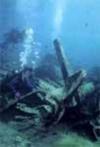
|
The Lartington
 Bermuda Bermuda
|
Max Depth: 31-35ft/9-11m
Average Viz: 71-80ft/22-24m
Entry Type: Boat
Bottom Composition: Sand
Aquatic Life: Plenty To See
|
 Rating: 5.00 by 1 divers
Rating: 5.00 by 1 divers
Spring: 71-75°F/22-24°C
Summer: 81-85°F/27-29°C
Fall: 76-80°F/24-27°C
Winter: 61-65°F/16-18°C
|
|


|
|
The Lartington is a boat accessible salt water dive site, located in Bermuda. This dive site has an average rating of 5.00 out of 5 from 1 scuba divers. The maximum depth is 31-35ft/9-11m. The average visibility is 71-80ft/22-24m.
1879 - English Steamer
The Lartington was an early vintage freighter that crashed into Bermuda’s reefs on December 14th 1879. The old steamer had departed Savannah, Georgia, for Russia with a cargo of cotton. Her voyage was not an easy one, she encountered numerous storms and heavy seas. A giant wave said to be in excess of 100 feet high crashed into her and cracked her hull, causing a massive leak. The water pumps could not keep ahead of the incoming seas and the Captain decided to make a run for Bermuda and help. She never made it. Instead the unlucky ship ran aground on the reef five miles north west of land after hitting a series of blind breakers known locally as "Pilchards & Dicks". Her momentum allowed her to travel about 200 yards until she eventually sank just to the north of The Montana.
Photo The 245 foot long vessel was known as a "tramp steamer". A tramp steamer was a ship that used both sail and steam to move around. On windy days she would generally travel under sail. If the wind dropped out, the crew would fire up her boilers and she would then steam. The boilers were heated by coal, this would cover the boat and sails in soot. This is why these ships were named tramps.
If you go out to "Pilchard And Dicks", on a flat calm day, you can still see the propeller blades of The Lartington embedded in the reef.
All of the crew were rescued and most of the cargo salvaged. Over the course of the years, she has collapsed on herself, and now lies on top of the reef, in about 35 feet of water. At low tide her upturned bow comes to within inches of the surface.
Wreck Certificate
The Lartlington is one of the wreck sites featured in the Bermuda Shipwreck Certificate Program
Divemasters Notes:
The Lartington is in excellent shape for a wreck of her age especially considering how she met her watery grave. On the bow, which has twisted to one side, you can still find the red, lead letters of her name. Thanks to a tourist submarine that used to visit here during the late 80’s and early 90’s which had appalling manoeuvrability or just plain lousy driving, the constant crashing into the wreck caused the letter "L" has disappeared, so this is now "The Lartington". The bow section is upturned a little like an "A frame". It is possible to swim into the bow, where you will find an air pocket with some 130 year old air in it!!! It has actually been changed several times since and a quick blast with an alternate air source should allow you enough air to take out your regulator and have a chance to hear how silly your voice sounds when you’re inside a ship at the bottom of the ocean. Some really silly people have actually proposed marriage in here. I’m informed that it is not contagious.
Two large boilers form the focal point of the mid section. These boilers come to within 6 feet of the surface. If you follow along the wreckage following the shaft towards the stern is the stub of the propeller which has become home to an huge anemone. Behind the propeller, you will find the remains of a massive rudder. The blades of the propeller can be found about 1/2 a mile to the north on the top of the shallow breaker reefs known as "Pilchard’s and Dicks"
There is quite often a large Margate or a Black Fin Grouper underneath the bow. By the stern, keep your eyes open for the resident school of French Grunts, which will upon your approach, surround you. In the sand pockets around the wreck, look out for Purple Heart Sea Urchins.
To the south of the wreck just beyond the bow, you will find a huge head of coral, there is a small cave on the eastern side, which typically houses between five and ten large Spiny Lobsters. This is also a fairly good area for finding shells, especially Tellin’s. Look out for Eagle Rays feeding off the Heart Urchins in the large sand beds.
The visibility on this wreck is usually fairly good, averaging 70 feet in the summer to well in excess of 200 feet during the winter months. The site is contained upon the wreck and as such navigation is very simple although if the services of a guide is offered, the area covered can increase significantly. I’ve been known to pass sections of The Montana whilst diving the wreck of The Lartington.
REMEMBER.... THE REEF IS FRAGILE! PLEASE DO NOT TOUCH OR TREAD ON LIVING CORAL.